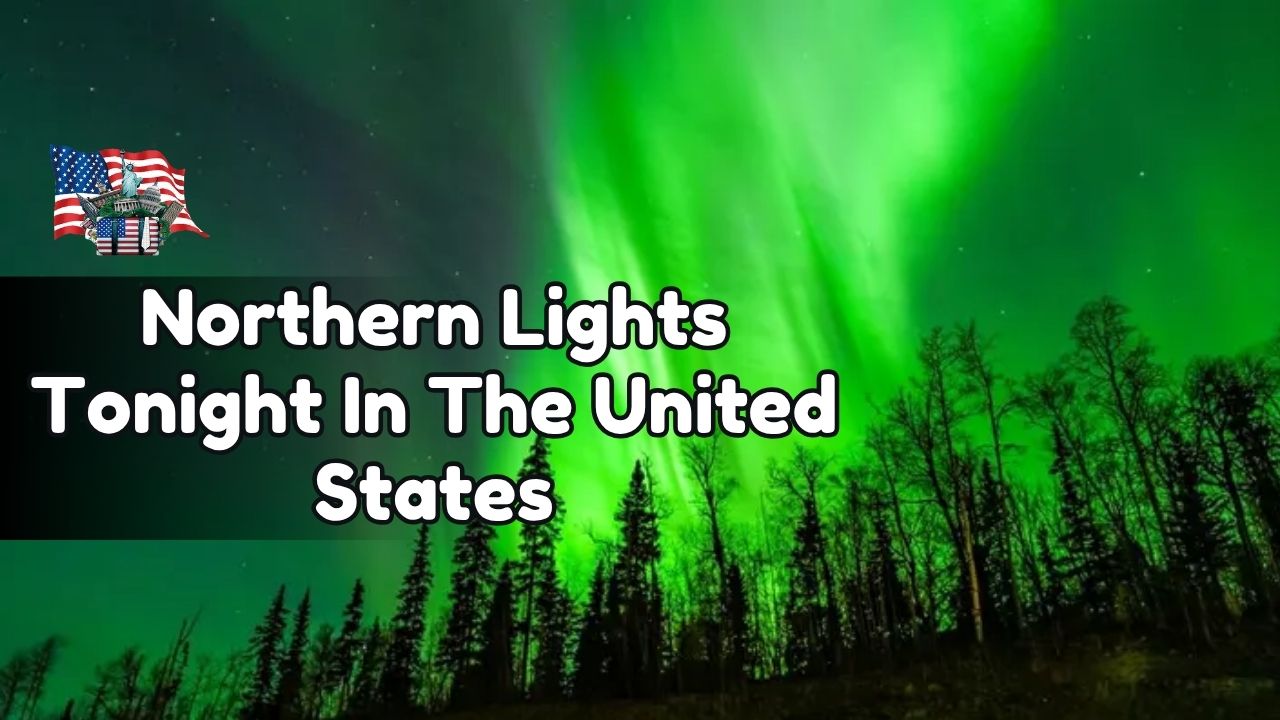The night of November 11 into the early hours of November 12, 2025, is expected to bring one of the most widespread northern lights displays in recent years across the United States. The US National Oceanic and Atmospheric Administration (NOAA) has predicted intense geomagnetic activity following a series of solar eruptions known as coronal mass ejections (CMEs). These powerful bursts of solar energy are set to collide with Earth’s magnetic field, creating the perfect conditions for a dazzling auroral show visible across 21 states.
For many skywatchers, this will be a rare opportunity to witness the aurora borealis far south of its usual Arctic home. NOAA’s upgraded G4 storm alert indicates strong solar winds capable of illuminating night skies from the Pacific Northwest to the Northeast and parts of the Midwest. With the right timing, clear skies, and minimal light pollution, millions of Americans could experience nature’s most mesmerizing light show without leaving their own backyard.
What NOAA Is Forecasting Tonight

The US National Oceanic and Atmospheric Administration has issued a rare, high confidence outlook for auroras visible far beyond the usual high latitudes. A sequence of coronal mass ejections over the last three days is arriving in close succession. NOAA’s Space Weather Prediction Center expects geomagnetic activity to strengthen through Monday evening, with storm levels reaching G3 to G4. This level of energy can push the auroral oval well into the northern United States and occasionally into parts of the central states if the interplanetary magnetic field tilts south for sustained periods.
A third CME tied to an X5.1 class solar flare is timed to graze or reach Earth by early Tuesday morning. That additional injection of solar material can prolong the display for some regions into the pre-dawn hours of November 12.
Short Summary
Item |
Details |
|---|---|
Dates |
Night of November 11 into early November 12 |
NOAA outlook |
Geomagnetic storm potential at strong levels G3 to G4 |
Why it is happening |
Multiple coronal mass ejections following an X5.1 solar flare |
Where to look |
Northern sky, away from city lights, in the 21 listed states and possibly farther south if activity intensifies |
Best time window |
After sunset on Nov 11, peaking near local midnight, lingering into early Nov 12 |
Possible impacts |
Temporary satellite, radio, and high latitude power grid disturbances |
Official site |
NOAA Space Weather Prediction Center: www.swpc.noaa.gov |
States With The Best Odds Of Seeing The Aurora
As of November 11, the aurora oval is projected to include or brush the following states. Local cloud cover and light pollution remain the deciding factors for visibility.
- Alaska
- Washington, Idaho, Montana, Wyoming
- North Dakota, South Dakota, Nebraska
- Minnesota, Iowa, Wisconsin, Illinois, Indiana, Michigan, Ohio
- New York, Pennsylvania, Vermont, New Hampshire, Massachusetts, Maine
Past storms of similar strength have briefly pushed faint visibility as far south as Kansas and northern Missouri. That type of extension is not guaranteed. It depends on real time solar wind conditions and the strength of the geomagnetic field coupling.
Best Time To Watch
NOAA’s three day outlook points to an evening ramp up on November 11. Use the windows below as a planning guide, then adjust in real time if the storm strengthens.
- Late afternoon to evening: Minor storm levels are possible from roughly 4 p.m. to 10 p.m. EST. Faint arcs may appear low on the northern horizon in the far northern states.
- Late evening to near midnight: Strong G3 activity is most likely between 10 p.m. and 1 a.m. EST. Northern tier states have the best chance of structured forms like curtains, rays, and occasional reds or purples.
- After midnight to early morning: Visibility can persist in bursts through the pre-dawn hours of November 12, especially if the third CME arrival keeps conditions elevated.
Tip for the Midwest and Northeast: Many events peak near local midnight, but brief substorms often erupt earlier. Step outside every 20 to 30 minutes rather than waiting for a single perfect hour.
Why This Event Stands Out
Auroras light up when charged particles from the Sun travel down Earth’s magnetic field lines and energize atmospheric oxygen and nitrogen. The current solar cycle has entered an active phase in 2025. The recent X5.1 flare from active region AR3542 launched fast moving plasma at speeds above 1,800 kilometers per second. Multiple arrivals in close sequence can amplify the geomagnetic response and produce vivid colors deeper into the continental United States.
Practical Viewing Tips
- Go dark and go north: Choose a site with a clear northern horizon. Lake or prairie vistas work well.
- Minimize light: Turn off vehicle lights. Avoid phone flashlights once you are set up.
- Let your eyes adapt: Allow at least 30 minutes without bright screens.
- Use a camera boost: Modern phones capture auroras better than the naked eye. Switch to night mode, reduce exposure compensation at first, then increase as needed. For DSLRs or mirrorless cameras, start with ISO 1600 to 3200, aperture as wide as possible, and 5 to 10 second exposures, then tune.
- Check clouds: High clouds mute detail. Low broken clouds can add drama if gaps remain to the north.
Safety And Possible Disruptions
Strong geomagnetic storms can trigger short lived issues. Power operators in high latitudes may see voltage fluctuations. Satellites can experience orientation anomalies. High frequency radio can fade at times. Airlines occasionally modify polar routes during peak radiation periods. These effects are typically managed by the relevant operators. For the public, the event is safe to watch with the naked eye.
What If You Live Outside The Listed States
If you are south of the core projection, you might still catch a low, pale glow. Look for a steady arch or diffuse band near the northern horizon that can brighten and sprout vertical rays during substorms. Use a camera to confirm faint activity. If geomagnetic indices spike, drive 30 to 60 minutes toward darker skies and recheck.
How To Track Real Time Conditions
- NOAA SWPC nowcast and alerts: watch the short term Kp index, solar wind speed, density, and Bz direction.
- Local weather radar and satellite: ensure clouds are not filling in from the west or north as the night progresses.
- Light pollution maps: moving a few miles away from town can make the difference between no view and a memorable display.
Frequently Asked Questions
1) What time should I go outside for the best chance of seeing auroras
Aim for 10 p.m. to 1 a.m. local time, with bonus chances from dusk through the pre-dawn hours if storm levels remain strong.
2) Can I see the northern lights from a city
Urban light severely reduces visibility. Drive to a dark sky site with a clear view to the north for the best results.
3) Which direction should I look
Face north. If you are in Alaska or the far northern states, look overhead and across the entire sky as the oval can sit directly above you.
4) Will the aurora be visible two nights in a row
Yes if elevated conditions persist. With multiple CMEs in play, activity can linger into the next night, although intensity varies.
5) Is it safe to watch and photograph auroras
Yes. Auroras are safe to view with the naked eye and standard camera equipment. There is no special eye protection required.
Conclusion
Tonight offers one of the best aurora opportunities of the year for the northern United States, with the possibility of surprise appearances farther south if the geomagnetic field couples strongly. Prepare a dark sky plan, check clouds, and build in time to scan the northern horizon. The combination of multiple CME arrivals and an energetic solar cycle sets the stage for a vivid and possibly widespread display.
Official Site: NOAA Space Weather Prediction Center: www.swpc.noaa.gov
For More Information Click HERE











